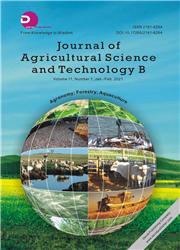Interference of Quinolinate Phosphoribosyltransferase Gene QPT Affects Agronomic Traits and Leaf Quality in Nicotiana tabacum L.
引用次数: 0
Abstract
Quinolinate phosphoribosyltransferase (QPRTase), a key enzyme in ensuring nicotinic acid is available for the synthesis of defensive pyridine alkaloids in Nicotiana species, also plays an important role in nicotinamide adenine dinucleotide (NAD) biosynthesis. In this study, the morphological traits, the quality characteristics and photosynthetic parameters in QPT-overexpressing/interfering tobacco plants were investigated, respectively. Results showed that the interference of QPT gene not only reduced significantly the morphological traits including plant height, stem girth, leaf number and leaf length, etc. at 20 days after transplanting (DAT), but the flowering period was delayed 10-15 d in interfered tobaccos compared with the overexpressed, control and wild-type counterparts. However, at 40 DAT and 60 DAT, only three indexes (plant height, stem girth and leaf number) in QPT-interfering plants appeared significant difference in comparison with other three types of tobacco lines. Meanwhile, the determination results from nicotine, sugar, K and Cl content showed the nicotine content in interfered plants was always significantly lower than that in overexpressed plants, control and the wild-type ones respectively whatever toppling or not. At the same time, the toppling treatment also caused the increasement of K content among the four different tobacco lines, but the maximum increase amplitude of K content was found in QPT-overexpressing tobaccos while the minimum appeared in QPT-interfering plants. Finally, QPT-interference in transgenic tobaccos likewise affected the photosynthesis by reducing net photosynthetic rate (Pn), stomata conductance (Gs) and transpiration rate (Tr), while there was no significant difference between QPT-overexpressing plants and the controls and the wild-types.喹啉酸磷酸核糖转移酶基因QPT的干扰对烟草农艺性状和叶片品质的影响。
Quinolinate phosphoribosyltransferase (QPRTase)是保证烟叶中烟酸合成防御性吡啶类生物碱的关键酶,在烟酰胺腺嘌呤二核苷酸(NAD)的生物合成中也起着重要作用。本研究对qpt过表达/干扰烟草植株的形态特征、品质特征和光合参数进行了研究。结果表明,QPT基因的干扰不仅显著降低了移栽后20 d烟叶的株高、茎长、叶数、叶长等形态性状,而且与过表达、对照和野生型相比,干扰烟叶的花期推迟了10 ~ 15 d。而在40和60个处理期,qpt干扰株系只有株高、茎周长和叶数3个指标与其他3种株系相比有显著差异。同时,烟碱、糖、K和Cl含量测定结果表明,无论是否倒伏,干扰植株的烟碱含量均显著低于过表达植株、对照植株和野生型植株。同时,倒伏处理也引起了4个烟系间钾含量的增加,但过表达qpt的烟系钾含量增加幅度最大,干扰qpt的烟系钾含量增加幅度最小。最后,qpt对转基因烟草的干扰同样通过降低净光合速率(Pn)、气孔导度(Gs)和蒸腾速率(Tr)来影响光合作用,而过表达qpt的植株与对照和野生型之间无显著差异。
本文章由计算机程序翻译,如有差异,请以英文原文为准。
求助全文
约1分钟内获得全文
求助全文

 求助内容:
求助内容: 应助结果提醒方式:
应助结果提醒方式:


